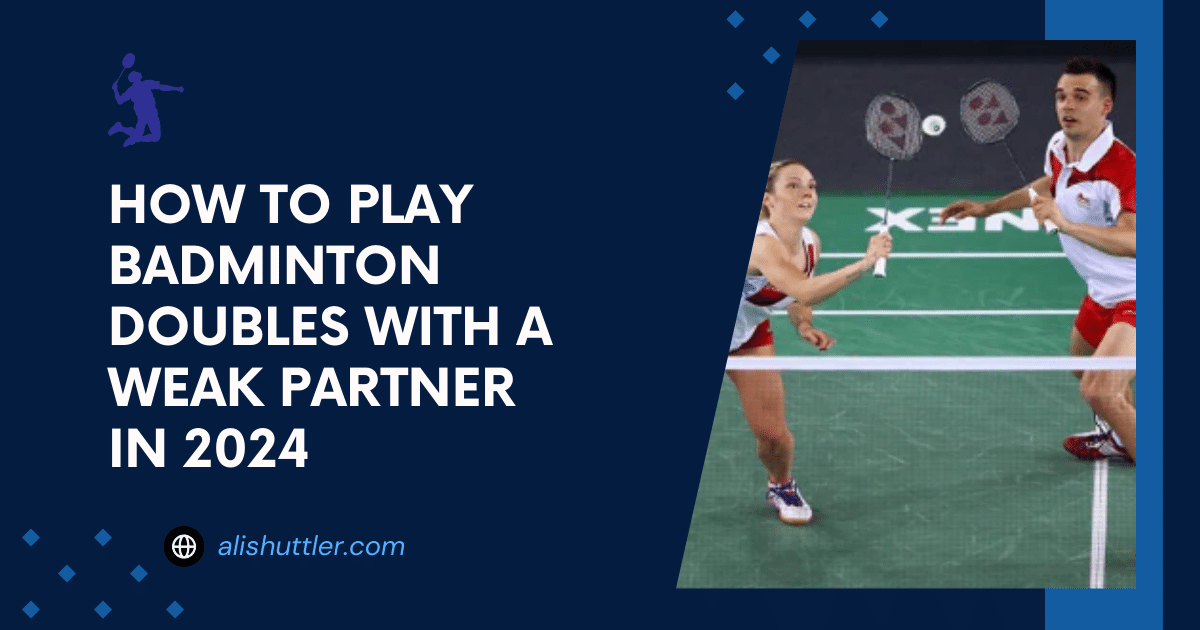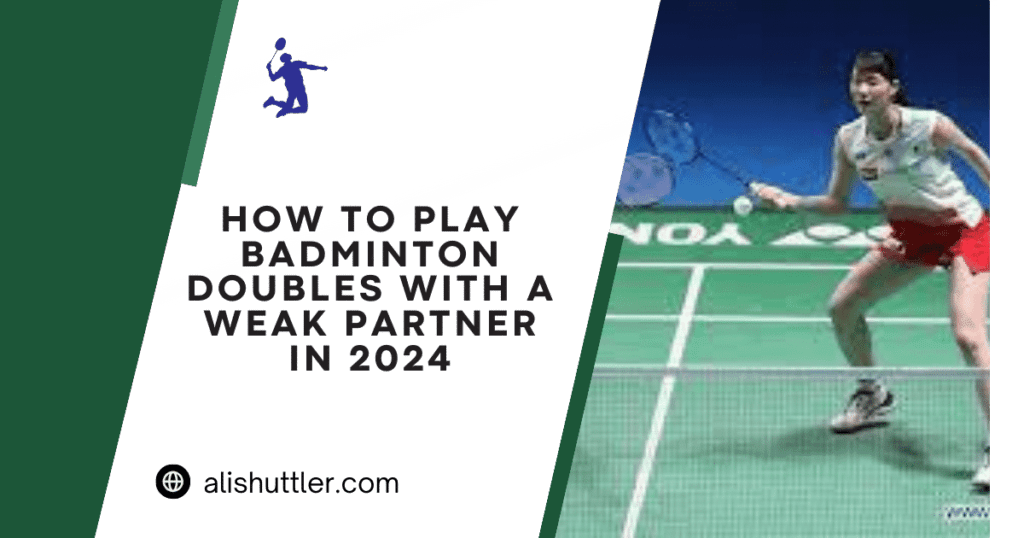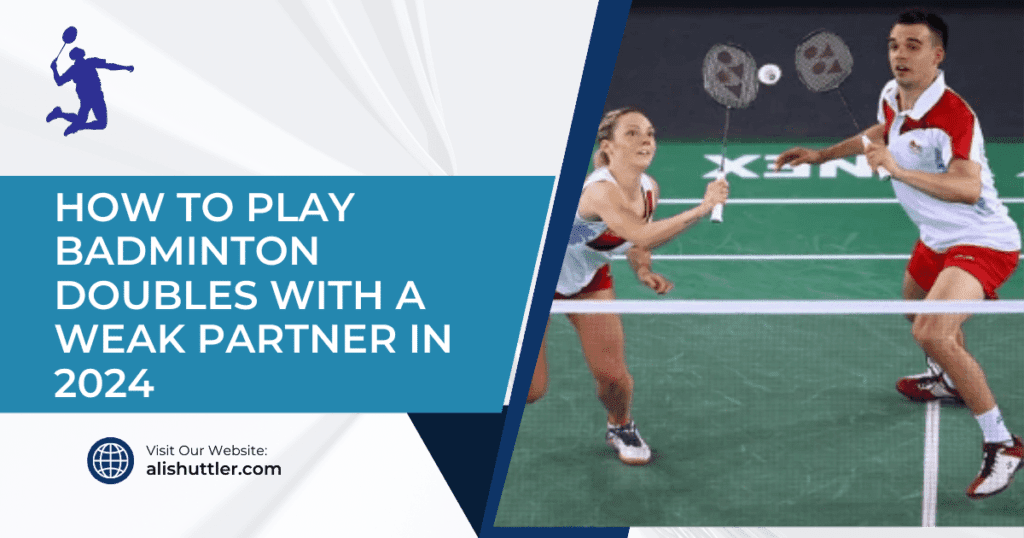Did you know that playing badminton doubles with a weaker partner can improve your game? Many players find themselves in this situation, and it can be challenging. However, some strategies and techniques can turn this potential weakness into an advantage on the court. In this post, we’ll explore practical tips for adapting your play style, effective communication methods, and how to capitalize on each other’s strengths. Whether you’re a seasoned player or just starting, these insights will help you elevate your doubles game while fostering teamwork and enjoyment.
Table of Contents
Understanding Your Partner’s Skill Level
Assessing Strengths and Weaknesses
To play badminton doubles with a weak partner, it’s crucial to first understand their skill level. Observe how they serve, return shots, and play around the court. Pay attention to their strengths, like good footwork or accurate shots, as well as weaknesses such as slow reflexes or difficulty covering the court. For instance, if your partner struggles with fast-paced rallies but has strong smashes, you can adjust your strategy accordingly.
It’s also important to evaluate your skills honestly. Consider what you bring to the game and how you can complement your partner’s abilities. If you’re agile and quick on the court, focus on covering more ground during games so that both of you can compensate for each other’s weaknesses effectively.
Adapting Playing Style
Once you’ve assessed both your and your partner’s strengths and weaknesses, adapt your playing style accordingly. For example, if your partner has difficulty returning smashes from opponents due to slow reflexes, position yourself strategically to cover areas where they might struggle. This way, even if they miss a shot due to their weaker side of play (like backhand), you’ll be there ready for backup.
Communicating openly is key in understanding how comfortable your partner feels during games. Encourage them by acknowledging improvements while also addressing areas that need work without being critical.
Effective Communication for Stronger Teamwork
Clear Signals and Cues
Establishing clear signals and cues with your partner is crucial in playing badminton doubles, especially when one of the players has a weaker skill level. Use simple hand gestures or verbal cues to communicate effectively during the game. For example, agree on specific signals for when to switch positions, who should take the shot, or when to cover each other’s weaknesses. This will help both players anticipate each other’s moves and compensate for any skill discrepancies.
It’s essential to ensure that your partner understands these signals clearly. Practice them during training sessions so they become second nature during actual matches. By doing this, you can minimize misunderstandings and confusion on the court while playing.
Positive Language and Constructive Feedback
Using positive language and providing constructive feedback can greatly impact how well you work together as a team. Encourage your partner with words of support and motivation throughout the game. Instead of focusing on mistakes, offer constructive feedback in a supportive manner that helps your partner improve without feeling discouraged.
For instance, if your weak partner misses a shot, avoid criticizing them harshly; instead, offer encouragement by highlighting what they did well before gently suggesting areas for improvement. This approach fosters a more positive atmosphere between partners while also promoting continuous learning and growth.
Supporting and Encouraging Your Partner
Offer Encouragement and Praise
Supporting a partner who may be struggling in a game of badminton doubles is crucial for maintaining a positive atmosphere on the court. By offering words of encouragement and praise, you can help boost your partner’s confidence. For example, when they make a good shot or show improvement, acknowledge it with positive affirmations like “Great shot!” or “You’re doing awesome out there!”
It’s important to remember that even small gestures of support can go a long way in making your partner feel more confident. Simple phrases like “Keep it up” or “You’ve got this” can provide the reassurance they need to keep pushing forward, despite any challenges they may be facing during the game.
Provide Constructive Feedback
While it’s essential to offer praise, providing constructive feedback is equally important. When giving feedback to your partner, ensure that it is delivered in a supportive manner. Instead of pointing out their weaknesses, focus on areas where they can improve and offer suggestions for enhancement.
For instance, if you notice that your partner struggles with returning serves from one side of the court, gently suggest practicing together to work on those specific skills. This approach not only helps them grow as a player but also reinforces the idea that you are invested in their progress as part of the team.
Simplifying Your Game Plan

Focus on Basics
When playing badminton doubles with a weaker partner, focus on basic shots like the clear, drop shot, and serve. Keep it simple to avoid overwhelming your partner.
Positioning is crucial in badminton. Make sure to cover the key areas of the court effectively. For instance, if your partner struggles at the net, take charge of that area.
Prioritize Consistency
Consistency trumps everything when playing with a less experienced teammate. Instead of attempting flashy or complex techniques, prioritize hitting consistent and reliable shots.
Remember that keeping rallies going is more important than trying risky shots that could result in errors. By maintaining a steady rhythm, you can keep control of the game and allow your partner to gain confidence.
Adjust Strategy
It’s essential to adjust your strategy based on your partner’s capabilities. If they struggle with overhead shots, consider using lobs or clears instead.
Communication is key here; make sure to discuss tactics and agree on a game plan that suits both players’ strengths and weaknesses.
Coordinating Movements and Rotations
Coordinate Movements
In badminton doubles with a weak partner, it’s crucial to coordinate movements effectively. If your partner struggles with backhand shots, try to cover that area by positioning yourself strategically. For example, if your partner is weaker at the net, you can position yourself slightly forward to cover more of the front court.
Communicate with your partner during the game. You can use simple signals or verbal cues to indicate where you’ll be moving and which shots you’ll be covering. This way, both of you can anticipate each other’s movements and adjust accordingly.
Synchronized Footwork and Positioning
Practice synchronized footwork and positioning as a team to compensate for any weaknesses in your partnership. By practicing specific drills together, such as moving in harmony from side to side on the court or transitioning between defensive and offensive positions smoothly, you can build a stronger sense of coordination.
For instance, if one player tends to struggle when forced into a defensive position due to slower reactions or movement speed, focusing on drills that improve defensive positioning could help mitigate this weakness.
Remember that anticipation plays a key role in enhancing coordination between partners. By understanding each other’s strengths and weaknesses through practice sessions and actual games, you will naturally start anticipating each other’s actions better over time.
Managing Mistakes and Maintaining Morale
Avoid Blaming
When playing badminton doubles with a weak partner, it’s crucial to avoid blaming each other for mistakes. Instead of pointing fingers, focus on supporting one another. Remember, everyone makes mistakes, and the key is to learn from them.
It’s important to understand that responsibility should be shared equally between both partners. If your teammate makes an error, resist the urge to criticize or express frustration. This can lead to a negative atmosphere and hinder your performance as a team.
Encourage Positive Mindset
After making mistakes on the court, it’s essential to stay composed and encourage a positive mindset in both yourself and your partner. Remind each other that errors are part of the learning process. By maintaining morale after mistakes, you can create an environment where both players feel supported and motivated.
One way to do this is by offering words of encouragement when things don’t go as planned. For example, if your partner misses a shot, you could say something like “Don’t worry about it! Let’s focus on the next point.” This helps in shifting the focus from past errors towards future opportunities for improvement.
Controlling the Pace to Your Advantage
Set the Pace
When playing badminton doubles with a weaker partner, it’s essential to set the pace of the game in a way that suits both players. For instance, if your partner struggles with fast-paced rallies, consider slowing down the game by using drop shots and lobs. This allows your partner to comfortably reach and return shots without feeling overwhelmed. On the other hand, if your partner is more comfortable with aggressive play, you can adjust your strategy accordingly.
It’s crucial to communicate openly with your partner about their comfort level and adapt accordingly during gameplay. By understanding each other’s strengths and weaknesses, you can create a playing style that maximizes both players’ potential.
Vary Shot Speed
To gain an advantage over opponents while playing with a weaker partner, varying shot speed is key. Mixing up slow and fast shots not only keeps opponents on their toes but also disrupts their rhythm. For example, alternating between powerful smashes and gentle drops can catch opponents off guard and force them into making errors.
By incorporating this tactic into your gameplay strategy, you not only make it easier for your weaker partner but also increase the chances of unsettling stronger opponents who may struggle to anticipate varied shot speeds.
Strategic Pauses
Integrating strategic pauses into gameplay provides an opportunity for both players to regroup mentally and physically. Use these moments to discuss tactics or offer encouragement if needed. These brief breaks allow for refocusing on strengths while addressing any areas that need improvement without feeling rushed or pressured.
Preventing the Opponent’s Focus on Your Partner

Deceptive Shots
Using deceptive shots is a great way to keep the opponents on their toes. By employing techniques like drop shots, smashes, or cross-court shots, you can make it challenging for your opponents to predict your next move. This uncertainty forces them to focus equally on both you and your partner. For example, if you execute a powerful smash that catches the opponents off guard, they will need to be prepared for similar moves from both players.
Employing deceptive shots also gives your partner more opportunities to showcase their skills. When the opponents are unsure about where the shuttlecock will go next, they won’t be able to solely concentrate on countering their partner’s weaknesses.
Tactical Maneuvers
Another effective strategy is using tactical maneuvers that force the opponents to divide their attention between both players. For instance, executing quick rotations and position switches with your partner can create confusion for the opposing team. By constantly changing positions and alternating who takes charge at the front or back of the court, you compel the opponents to stay alert and adapt quickly.
Varying shot placements and angles can also help in diverting attention away from any perceived weaknesses in your partner’s game. If one player consistently directs shots toward different areas of the court while switching up shot types (e.g., clears, drops), it becomes harder for opposition pairs to exploit any vulnerabilities in either player’s performance.
Closing Thoughts on How to Play Badminton Doubles with a Weak Partner?
Playing badminton doubles with a weaker partner can be both challenging and rewarding. Understanding your partner’s skill level, communicating effectively, and supporting them are crucial for a successful partnership on the court. By simplifying your game plan, coordinating movements, managing mistakes, and controlling the pace, you can adapt your play to complement your partner’s abilities. Remember, it’s not just about winning but also about enjoying the game together.

So, next time you step onto the court with your weaker partner, keep these strategies in mind. With patience, encouragement, and teamwork, you can turn the game into a positive experience for both of you. Embrace the opportunity to grow together as a team and savor every moment of improvement. Good luck and have fun on the court!
Frequently Asked Questions
How can I effectively communicate with my weak badminton doubles partner?
To effectively communicate with your weak badminton doubles partner, use clear and positive language. Offer constructive feedback and focus on improvement rather than shortcomings. Encourage open dialogue to understand each other’s strengths and weaknesses.
What are some strategies for supporting and encouraging a weaker partner in badminton doubles?
Support your weaker partner by acknowledging their efforts, providing constructive feedback, and offering encouragement. Focus on building their confidence by highlighting their strengths and progress. Emphasize teamwork and the collective effort to boost morale.
How can I simplify our game plan when playing badminton doubles with a less skilled partner?
Simplify your game plan by focusing on basic techniques, such as consistent serves, positioning, and simple shot selections. Emphasize playing to your partner’s strengths while minimizing complex strategies that may overwhelm them.
What are effective ways to coordinate movements and rotations with a less skilled badminton doubles partner?
Coordinate movements by establishing clear signals or cues for position changes during play. Practice specific scenarios together to develop synchronized movements. Prioritize understanding your partner’s tendencies to anticipate their actions more effectively.
How do I manage mistakes while maintaining morale when playing badminton doubles with a weaker teammate?
Manage mistakes by reframing them as learning opportunities rather than failures. Maintain positivity through supportive communication, emphasizing progress over perfection. Remind yourselves that mistakes are part of the learning process in improving performance.

